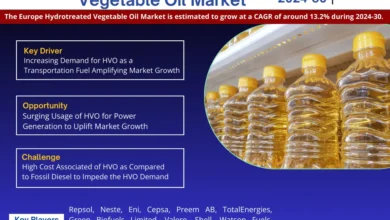Aluminium Can Production Process with Cost Analysis: A Comprehensive Report by Procurement Resource
In a world increasingly driven by sustainability and efficiency, the production of aluminium cans stands out as a pivotal industry. Aluminium cans are ubiquitous, found in everything from beverages to pharmaceuticals, offering a combination of durability, lightweight properties, and recyclability. The latest report by Procurement Resource delves deep into the aluminium can production process, providing a detailed cost analysis that is essential for stakeholders in the industry. This comprehensive assessment covers every aspect of the production process, market drivers, raw material requirements, and crucial cost factors.
Request Free Sample – https://www.procurementresource.com/production-cost-report-store/aluminium-can/request-sample
Procurement Resource Assessment: Aluminium Can Production Process
Procurement Resource’s assessment of the aluminium can production process offers an in-depth analysis that spans the entire lifecycle of production. This includes the sourcing of raw materials, the various stages of manufacturing, and the final packaging and distribution. The report is structured to provide a clear understanding of each process step, ensuring that stakeholders can make informed decisions based on accurate data.
Understanding the Aluminium Can
Aluminium cans are a type of packaging made from aluminium sheets. They are predominantly used for beverages like soft drinks, beer, and juices, but also serve purposes in the food and pharmaceutical industries. The popularity of aluminium cans is largely due to their excellent properties: they are lightweight, corrosion-resistant, and have a high recycling rate. Additionally, aluminium cans provide a significant barrier to light, oxygen, and moisture, ensuring the longevity and quality of the product they contain.
Market Drivers
The aluminium can market is driven by several key factors:
- Sustainability and Recycling: Aluminium is one of the most recyclable materials available. The recycling process saves up to 95% of the energy required to produce new aluminium from raw materials, making it an eco-friendly option. The increasing emphasis on sustainability and environmental responsibility has significantly boosted the demand for aluminium cans.
- Consumer Preference: The rise in consumer preference for canned beverages, driven by convenience, portability, and the growing trend of on-the-go consumption, is a major market driver. Cans are also preferred for their ability to keep beverages fresh and carbonated for longer periods.
- Innovation and Design: Advances in can design and manufacturing technologies have led to improved aesthetics and functionality, attracting more brands to opt for aluminium cans. Innovations such as resealable cans and unique shapes have added to their appeal.
- Regulatory Support: Government regulations favoring the use of recyclable materials and the reduction of plastic waste have further propelled the aluminium can market. Policies and incentives for recycling and sustainability are creating a conducive environment for market growth.
Raw Material Requirements
The primary raw material for aluminium can production is aluminium ingots, which are processed into thin sheets. The quality and properties of these ingots are crucial, as they directly impact the quality of the final product. Other materials include:
- Lubricants: Used during the forming process to reduce friction and wear on the machinery.
- Coatings and Inks: Applied to the interior and exterior surfaces of the cans for protection and branding purposes.
- End Components: The can ends or lids, typically made from the same aluminium sheet, but sometimes include additional materials like plastics for specific designs.
Costs and Key Process Information
Understanding the cost structure of aluminium can production is vital for manufacturers and investors. The key cost components include:
- Raw Materials: The cost of aluminium ingots fluctuates based on market conditions and supply chain factors. This is the largest cost component in can production.
- Energy Costs: Aluminium production is energy-intensive, requiring significant electricity for smelting and processing. Energy costs can vary based on location and energy sources.
- Labor: Skilled labor is required for operating machinery and managing production processes. Labor costs are influenced by the region and the level of automation in the plant.
- Capital Costs: Investment in machinery and equipment is substantial. High-speed can-making lines, coating and printing machines, and quality control systems are significant capital expenditures.
- Maintenance: Regular maintenance of machinery to ensure optimal performance and prevent downtime adds to the operational costs.
Key Production Stages
- Casting: Aluminium ingots are cast into sheets.
- Rolling: The sheets are rolled to the desired thickness.
- Blanking and Drawing: Circular blanks are punched from the sheet and drawn into cup shapes.
- Redrawing and Ironing: The cups are redrawn to the final can shape and ironed to reduce wall thickness.
- Trimming: The can tops are trimmed to uniform heights.
- Cleaning and Coating: The cans are cleaned and coated internally to prevent corrosion.
- Printing: Exterior surfaces are printed with brand designs.
- Necking and Flanging: The tops of the cans are necked down and flanged to prepare for the lids.
- Seaming: Lids are seamed onto the can bodies.
Looking for an Exhaustive and Personalized Report?
Procurement Resource offers exhaustive and personalized reports that can significantly substantiate your business decisions. Our tailored reports provide a comprehensive analysis of the aluminium can production process, detailed cost breakdowns, and insights into market dynamics. Whether you are a manufacturer looking to optimize your production process or an investor seeking to understand the cost implications, our reports are designed to meet your specific needs.
Our reports also include a thorough analysis of the market landscape, identifying key players, trends, and opportunities. By leveraging our extensive industry knowledge and data, we help businesses navigate the complexities of the market and make strategic decisions that drive growth and efficiency.
Conclusion
The aluminium can production process is a complex but highly efficient method of creating one of the most sustainable packaging solutions available today. Procurement Resource’s detailed cost analysis report provides invaluable insights into every aspect of this process, from raw material procurement to final product delivery. By understanding the costs and key factors involved, businesses can enhance their production strategies, optimize costs, and contribute to a more sustainable future.
For an in-depth and personalized assessment of the aluminium can production process, tailored to your business needs, reach out to Procurement Resource. Our expertise and comprehensive analysis can provide the foundation for informed decision-making and strategic planning in this vital industry.
About Us:
Procurement Resource is an invaluable partner for businesses seeking comprehensive market research and strategic insights across a spectrum of industries. With a repository of over 500 chemicals, commodities, and utilities, updated regularly, they offer a cost-effective solution for diverse procurement needs. Their team of seasoned analysts conducts thorough research, delivering clients with up-to-date market reports, cost models, price analysis, and category insights.
By tracking prices and production costs across various goods and commodities, Procurement Resource ensures clients receive the latest and most reliable data. Collaborating with procurement teams across industries, they provide real-time facts and pioneering practices to streamline procurement processes and enable informed decision-making. Procurement Resource empowers clients to navigate complex supply chains, understand industry trends, and develop strategies for sustainable growth.
Contact Us:
Company Name: Procurement Resource
Contact Person: Amanda Williams
Email: sales@procurementresource.com
Toll-Free Number: USA Canada – Phone no: +1 307 363 1045 | UK – Phone no: +44 7537 132103 | Asia-Pacific (APAC) – Phone no: +91 1203185500
Address: 30 North Gould Street, Sheridan, WY 82801, USA




